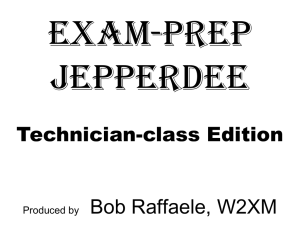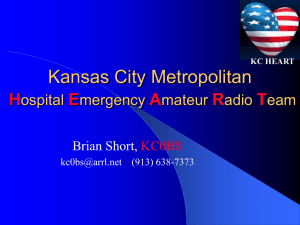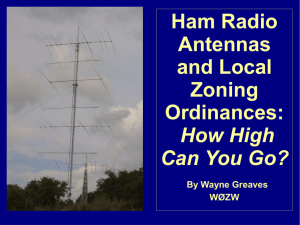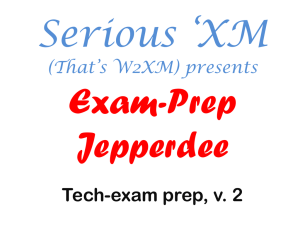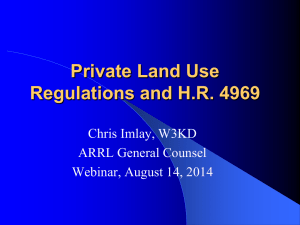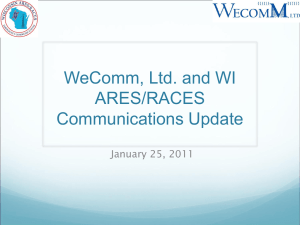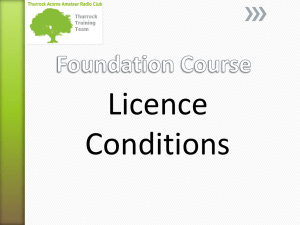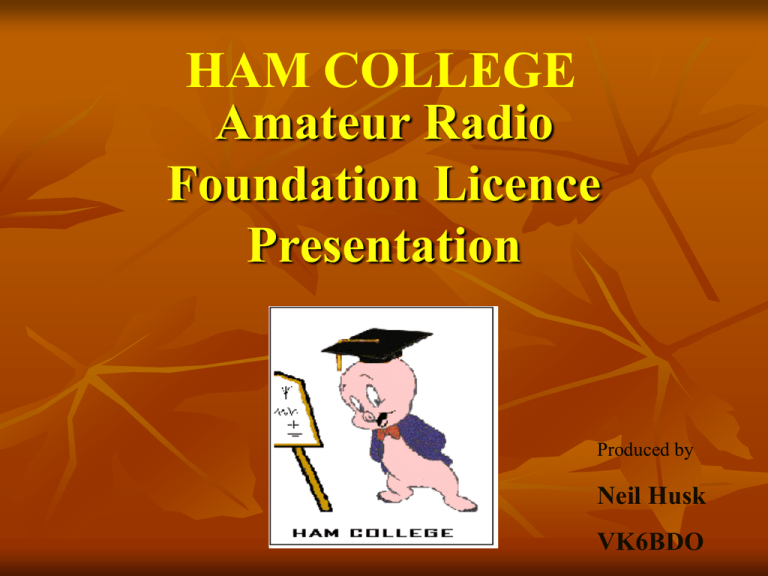
HAM COLLEGE
Amateur Radio
Foundation Licence
Presentation
Produced by
Neil Husk
VK6BDO
There are nine sections in the syllabus:
Nature of Amateur Radio.
Licence Conditions
Technical basics
Transmitters and Receivers
Transmission lines and Antennas
Propagation
Interference
Safety
Operating practices and Procedures
p87-92
Examination
The written exam consists of 25 multi choice type
questions which are to be completed in 30 minutes.
With the exam paper is an information sheet which will
contain formula, graphs, charts and diagrams to assist you
in answering the questions.
You must obtain 70% (18 correct) to pass the theory and
progress to the practical
The practical exam includes several oral questions and
will require you to do several demonstrations.
p 92
Nature of Amateur Radio
Amateur radio is intended to facilitate the hobby of radio
communications.
Amateur radio as a hobby has many aspects:
Technical Innovation
Emergency communications
Contesting
Satellite Communications
Digital Modes
Fox Hunting
And many more
p 55
Types of Licences
Amateur radio activities are authorised under an
amateur licence.
Other forms of licences authorise other types of radio
communication such as
Citizens Band (CB);
Land Mobile;
Point to Point links;
Broadcasting.
p 55
Licence Conditions
Operation of an amateur station is subject to the conditions
in the:
Radiocommunications Act 1992
Radiocommunications Regulations 1993
Radiocommunications Licence Conditions (Amateur
Licence) Determination No1 of 1997
Radiocommunications Licence Conditions (Apparatus
Licence) Determination 2003 (as amended)
The latest amendment was released in 2005.
p 56
Allocation of Frequency Bands
The Amateur Service operates on frequency bands
allocated for Amateur use.
Other services such as broadcasting, aeronautical and
maritime are allocated their own frequency bands.
The amateur service shares some frequency bands with
other services
The allocated bands are laid down in the LCD
P 55
Purpose of the Amateur Service
An Amateur Licence primarily authorises the operation of an
amateur station for:
Self training in radio communications;
Intercommunications between amateurs
Technical investigations into radio communications
p 55
Communications by Amateur Stations
Except in a distress or emergency situation the
amateur licence only authorises amateur to amateur
communications.
A Radio Inspector may authorise out of band
operations for a specific reason.
Amateurs may transmit messages on behalf of a third party
with in Australia provided it is not for gain, commercial
purposes, an advertisement or entertainment.
Third party messages to other countries depends on
that countries (the other country) laws.
p 55
Distress Signals
Distress signals are used where “imminent danger exists to
human life”
Distress communications are indicated by the use of the word
‘Mayday’.
Distress communications have priority over all other
communications.
Any person hearing a ‘Mayday’ communication are responsible
for passing the information to an appropriate authority.
p 57
Urgency Signals
Urgency signals are used where human life is not in
imminent danger but assistance is urgently required.
Urgency signals are indicated by the use of ‘Pan Pan’
Urgency signals receive priority of all communications
except distress signals.
Urgency signals should be reported to an appropriate
authority.
p 57
Question 1
An amateur licence allows the holder to transmit on:
A. Marine Bands
B. Aeronautical Bands
C. Amateur Bands
D. Any HF Band
ANSWER: C - Amateur Bands
Question 2
Amateur radio is intended to facilitate:
A. Commercial gain in radio communications
B. A way of saving on phone bills
C. A way of using unwanted commercial radio equipment
D. A hobby in radio communications
ANSWER:
D - A hobby in radio communications
Question 3
You hear an urgency message, you should:
A. Switch off your radio
B. Tell everyone on the frequency
C. Ring emergency services
D. Give the message priority
ANSWER: D - Give the message priority
Amateur Call Signs
Australian amateur call signs consist of two letters, followed by
one numeral and two, three or four letters.
VK6NT
VK6KTS
VK6FNBX
Australian call signs normally commence with the letters ‘VK’.
This is an international allocation to Australia.
Other allocations which may be issued to Aust amateurs are
‘VI and ‘AX’.
These are only issued for special events on a temporary basis.
p 58, 69-70
Amateur Call Signs
The numeral identifies the State or Territory in which the
amateur is licensed to operate.
1
2
3
4
5
6
7
8
9
0
Australian Capital Territory
New south Wales
Victoria
Queensland
South Australia
Western Australia
Tasmania
Northern Territory
External Territories
Antarctica
p 69
Amateur Call Signs
The remaining two, three or four letters identify the type of
licence held by the operator.
Any two letter suffix, or three letter suffix that begin with
A, B, C, D, E, F, G, J, K, T, U, W, X, Y & Z
indicate an advanced licence.
A three letter suffix beginning with H, L, M, N, P & V
indicate a Standard licence.
Four letter suffix’s are Foundation licences.
Three letter suffix beginning with R are repeaters or beacons.
p 70
Station Identification
The correct identification for an amateur station is the call sign
allocated to that station.
Station identification must be transmitted at the beginning of a
transmission or series of transmissions, at least every ten minutes
during the series of transmissions and at the end of the series.
A series of transmissions is a continual conversation between
two or more stations.
Any transmission must be contain station identification.
p 57
Q Codes
Three letter groups commencing with Q were originally
introduced to shorten commonly used phrases particularly when
using morse code.
They can be used to clarify common messages when
conditions are not good or there is a language difficulty.
When using voice communications under good conditions it
is not necessary to use Q codes.
As foundation licensees you are not required to know any of
the Q code but do need a knowledge of what it is for.
p 81
Secret Messages
The transmission of secret coded or encrypted messages is
generally not permitted.
The only allowable use of coded or encrypted signals is for
the control of satellites, repeaters, beacons etc.
p 55, 58
Transmission of Entertainment
The transmission of any form of entertainment is not
permitted.
p 55
General Do Not’s
An amateur station may not be used for commercial gain.
An amateur station may not be used to advertise any item
or service.
Subjects on which many people have very strong opinions
can easily cause heated arguments or can cause individual
offence, such as Religion, Politics or Sex should be avoided.
p 55
Question 4
An amateur call sign VK2BH would belong to:
A. An American licensed technician in Boston
B. An Australian licensed amateur in NSW
C. A foreign amateur operating in Australia
D. An Amateur licensed in Venezuela
ANSWER: B - An Australian amateur in NSW
Question 5
All amateur transmissions must include:
A. Your name
B. Your location
C. The power being used
D. Your call sign
ANSWER: D - Your Call sign
Question 6
An amateur must produce their licence for:
A. Anyone who asks for it
B. Local government inspectors
C. ACMA inspectors
D. A person claiming interference from your station
ANSWER: C - ACMA inspectors
Radiotelephony Procedures
Before looking at the actual procedures,
Radio telephony is voice and radio telegraphy is morse code.
Before transmitting always listen to ensure you will not
interfere with another transmission already in progress.
Remember that you may not be able to hear both sides of
another conversation.
If in doubt – ask “is the frequency in use”.
Avoid using Slang or big words.
Remember you never know who listening.
p 60, 61
Radiotelephony Procedures
Radio telephony is voice and radio telegraphy is morse code.
The call in telephony consists of:
The call sign of the called station not more than three times;
The words “This is”;
The call sign of the calling station not more than three times
The word “Over”
VK6KTS VK6KTS VK6KTS THIS IS
VK6BDO VK6BDO VK6BDO OVER
p 61
Radio Telephony Procedures
A general call to any station may be made by substituting the
signal ‘CQ’ for the called station.
CQ CQ CQ THIS IS VK6BDO VK6BDO VK6BDO OVER
On certain occasions a station may modify a CQ call with an
additional designation.
CQ DX - calling CQ but wants a distant station.
CQ JOTA - Any JOTA station.
CQ Contest - Any contest station
p 62
Radio Telephony Procedures
A reply to a call should consist of:
The call sign of the calling station not more than three times;
The words “This is”
The call sign of the replying station not more than three times
The word “Over”
VK6BDO VK6BDO VK6BDO THIS IS
VK6KTS VK6KTS VK6KTS OVER
p 62
Authorised Frequency Bands
and Emission Modes
Each grade of amateur licence allows the use of different
frequency bands and emission modes that may be used on
each band.
The permitted frequency bands and the modes
permitted on that band, for each grade of licence are
shown in the LCD.
p 59 & LCD
Authorised Frequency Bands
and Emission Modes
LCD
Permitted Output Power
The Amateur Foundation Licence allows a maximum
power output of 10 Watts when using Single Side Band
(SSB), Amplitude Modulation (AM), Frequency
Modulation (FM) or Carrier Wave (CW) emissions.
p 58
Type of Equipment Allowed
The Foundation Licence only authorises the use of
unmodified, commercially manufactured transmitting
equipment.
p 58
Equipment Must Not Be Modified
The Foundation licensee must not make any modifications to
any amateur radio transmitting equipment.
p 58
Harmful Interference
A licensee must not operate a Amateur station if
operation causes harmful interference to other radio
services.
p 54
Restriction of Operation
The ACMA has the right to restricted the operation of an
amateur station to avoid interference.
p 58
Inspection of Amateur Licences
ACMA inspectors have the right to require an amateur to
produce his/her licence.
ACMA inspectors have the right to inspect stations.
Inspectors also have the right to confiscate any unlawful
equipment or equipment that is capable of being used in
an unlawful manner.
p 58 &
Radio Regs
Notification of Change of Address
An amateur licence is issued to operate from a specific
address.
The ACMA must be notified of any permanent change of
address within 7 days of the change.
Operation from a temporary address may be continued for up
to four months.
p 58
Authorised use of Amateur Stations
A Foundation licensee may authorise a suitably Qualified
person to operate the licensee’s Amateur Station.
To operate a station is to control the transmitting
equipment.
A qualified person is a person who has a certificate of
proficiency – not necessarily a licence.
You can only authorised a person to your licence level.
Third Party Traffic
Do Not Confuse this with Authorised Station Use
To operate a station is to control the transmitting equipment.
If the licensee is in control of the station anyone may use
the microphone and talk.
You may also pass messages, within Australia, for a person
other than the amateur you are talking to.
This is termed “Third Party Traffic”
Other countries may not allow this and it is subject to the
other countries laws.
p 56
Question 7
Foundation licence holders must use equipment that
is:
A. A specified brand.
B. Unmodified transmitting equipment
C. Modified transmitting equipment
D. Second hand equipment
ANSWER: B. Unmodified transmitting equipment
Question 8
A message on behalf of a third party is subject to:
A. The number of words
B. Where the third party is located
C. OK on some frequencies
D. Regulatory Conditions
ANSWER: D. Regulatory Conditions
Question 9
Specified bands and emissions for amateur operators are
contained in:
A. Transceiver user manuals
B. Amateur radio journals
C. Foundation manual
D. Licence conditions determination
ANSWER: D Licence Conditions Determination
Technical Basics
The universe is made up of matter.
All matter is made up of atoms
Atoms consist of charged particles called protons, neutrons
and electrons.
Protons have a positive charge; electrons have a negative
charge while neutrons are not charged
It is these charged particles that give rise to electricity as
we understand and apply it in todays electronic
applications.
Electricity
When two charged bodies are placed close together or
connected, like charges will repel and unlike charges will
attract each other.
+
Repel
Attract
If unlike charges are connected by a material that will allow
the charges to move through it the charges will attempt to equal
the number of protons (+) and electrons(-) in each body.
Electricity
If a substance allows electrons to move through it easily it
is known as a conductor.
If it does not allow the passage of electrons it is an
insulator.
The flow of electrons along a conductor, to equal the
charges, is an electric current.
p 7, 8
Electric Current
An electric current is the ordered flow of electrons along a
conductor.
Because the electrons are the particles that can move the
flow will be from negative to positive.
Electric current is represented in formula and circuit
diagrams by the symbol ‘I’.
Current is measured in Amperes (A).
p 10
Electrical Pressure
For a current to flow there must be a difference in charge
between two points.
The difference in charge is known as a Voltage, Potential
Difference or Electromotive Force.
Voltage uses the symbol ‘V’ or ‘E’ for formula.
Voltage is measured in Volts (V).
p 10
Resistance
For a current to flow there must be a conductor connecting
two points of different voltage.
Where ever we have movement we have an opposing
force.
The opposition to current flow is Resistance.
Resistance uses the symbol ‘R’ for formula.
Resistance is measured in Ohms (Ω).
p 10
Ohms Law
In a circuit the Voltage (forward pressure), Current (Electron
Flow) and Resistance (opposition to flow) are related.
Ohms law states “The current in a circuit is directly
proportional to the Voltage and inversely proportional to the
resistance”.
V
As a formula - I = V/R
Or
V = IR
Or
R = V/I
I
R
NOTE: These formula are on the exam information paper.
p 11
Power
Power is the ability of a force to do work.
In electrics, this can be turning a motor, causing a light bulb
to glow or causing an electromagnetic wave to form around
an antenna.
Electrical power uses the abbreviation ‘P’ for formula.
Electrical power is measured in Watts (W).
p 12
Power
Electrical Power depends upon the Voltage and Current
in the circuit.
As a formula: P = VI
Or
V = P/I
Or
I = P/V
P
V I
NOTE: These formula are on the exam information sheet.
p 12
Direct Current
Direct Current (DC): Flows in one direction only.
A battery provides a source of DC.
+
Provided there is a circuit current will flow from
negative to positive.
p8
Incorrect Polarity
Many simple devices, such as light bulbs, will operate on DC
regardless of which way the current is flowing.
The direction of current flow is known as the polarity of the
circuit.
More complex electronic devices and/or circuits can be damaged
if connected with incorrect polarity.
Excessive voltage can also damage electronic components.
Alternating Current
Alternating Current (AC): The direction of current flow
changes with time.
Voltage
Time
An alternator produces an AC current.
AC is easy to generate.
AC can be easily transformed to a different voltage.
p 8
Alternating Current
AC is easier to produce and transform than DC.
1 cycle
The AC wave shape is a sine wave.
One complete wave is one cycle.
Alternators and oscillators create sine waves (AC).
p 14
Frequency
1 Second
Frequency is the number of complete cycles per second.
Frequency is measured in Hertz (Hz).
The frequency shown above is 4 Hertz. Mains is 50Hz.
p 14
Question 10
An electric current is:
A. The voltage applied to a conductor.
B. The opposition offered to electrons in a circuit.
C. The ordered movement of electrons in a circuit.
D The heat generated by moving electrons.
ANSWER: C The ordered movement of electrons in a
circuit.
Question 11
Electrical Power in measured in:
A. Watts
B. Ohms
C. Volts
D. Hertz
ANSWER: A. Watts
Question 12
If 10 Volts is applied to a circuit containing 5 Ohms
resistance a current of _______ will result.
A. 0.2 Amps
B. 2 Amps
C. 0.5 Amps
D. 5 Amps
ANSWER: 2 Amps
I = V/R
Wavelength
In air, the velocity (v) of radio waves, is 300, 000,000 metres
per second.
The wave length is the distance the front of the wave has
travelled in the time taken for the wave to complete a cycle.
Distance travelled at 300,000,000 metres/sec
p 14
Electrical Units
Quantity
Indicator
Unit
Symbol
Voltage
V
Volt
V
Current
I
Amp
A
Resistance
R
Ohm
Ω
Power
P
Watt
W
Frequency
f
Hertz
Hz
Wavelength
λ
Metre
m
NOTE: Voltage is sometimes referred to as Potential Difference
or Electromotive Force (EMF), the symbol E may be used.
Unit Prefixes
Often the units we have to use are very small or very large.
Frequency is usually in thousands or millions of Hertz but
current is often in thousandths or millionths of an Amp.
To avoid writing f = 3562000Hz or A=0.00125A, scientific
prefixes are used.
Some of these are used every day.
1 Kilometre is a 1000 metres.
1 millimetre is 0.001 metres.
p 13
SI Units
Factor
Prefix
Symbol
Millionth
micro
µ or u
Thousandth
milli
m
Thousands
kilo
k
Millions
Mega
M
The prefix can be applied to any Unit.
2MV = 2 Mega volts (2,000,000V)
p 13
2mV = 2 milli volts (0.002V)
Examples of Prefixes
5000V = 5kV
Kilo is 1000. So 5000 divided by 1000 = 5
4.7kΩ = 4700Ω
Big unit to smaller unit - multiply
1500mA = 1.5 A
Little unit to bigger unit - divide
0.6MHz =
600 kHz
Big to little - multiply
1000 mA
Big to little - multiply
0.05 V
Little to big - divide
1A =
50mV =
5MΩ = 5,000,000 Ω
Big to little - multiply
Frequency and Wavelength
If wavelength is the distance travelled while one wave
completes then the frequency must affect the wavelength.
f = 1 Hz
With a frequency of 1Hz the
wavelength will be 300,000kms
1 Second
With a frequency of 3Hz the
wavelength will be 100,000kms
f = 3Hz
p 15
Frequency and Wavelength
The higher the frequency the shorter the wave length.
The lower the frequency the longer the wave length.
The conversion chart will
be available in the exam.
NOTE: The frequency is
in Megahertz
P 15
Question 13
1000 Volts is often represented as
A. 1mV
B. 1MV
C. 1kV
D. 0.1kV
ANSWER: C 1kV (kilovolt)
Question 14
Wavelength has the symbol ____ and is measured in______.
A. Ω and metres
B. µ and ohms
C. λ and metres
D. λ and Hertz
ANSWER: C. λ (lamda) and metres
Question 15
AC stands for:
A. Ascending Current
B. Analysis Current
C. Analogue Current
D. Alternating Current
ANSWER: D Alternating Current
Electro-magnetic Spectrum
Electromagnetic frequencies range from 0Hz to millions
of Exa hertz. (Exa = 1,000,000,000,000,000,000)
The area of interest to us is the audio and radio section of
the spectrum.
The normal hearing range is about 100Hz to 15 kHz.
The range for audio communication is 300Hz to 3kHz.
p 13
Radio Frequency Bands
Amateurs generally operate in the HF, VHF and UHF bands.
HF (High Frequency)
- 3 to 30MHz
VHF (Very High Frequency) - 30 to 300MHz
UHF (Ultra High Frequency - 300MHz to 3GHz
NOTE: These frequency bands will be on the exam information
sheets
p 14
Component Symbols
When drawing circuits, symbols are used to represent
components.
There are ten that need to be known.
In the practical section of your exam you will be shown
at least five which must be correctly identified.
The five must include the earth and antenna symbols
p 92
Component Symbols
Cell
+
-
Battery
A battery may consist of one or more cells.
The exact number of cells is not always shown, the dotted line
indicates more cells.
p 92
Component Symbols
Fuse
Lamp
Occasionally a fuse may be drawn as
A lamp may sometimes be shown as
R
These alternatives will not be shown in the exam.
p 92
Component Symbols
Resistor
Switch (Open)
A resistor may also be seen as
The switch above is a single pole single throw switch.
p 92
Component Symbols
Antenna
Earth
These two must be known and correctly identified
p 92
Component Symbols
Microphone
Loudspeaker
The loudspeaker may be seen as
None of the alternatives will be used in the exam.
p 92
Transmitters
A simple voice transmitter consists of:
A microphone
Audio amplifier
Frequency Generation stage - Oscillator
Modulator stage
RF Amplifier
Feed line and antenna
P 18
Transmitter Block Diagram
Antenna
1
Audio Stage
2
Modulator
Microphone
4
RF Power
Amplifier
3
Frequency
Generator
(Oscillator)
This is the diagram from which will be required to identify
blocks.
p 18
Modulation
The audio (or data) is combined with the carrier (radio
frequency) in the modulation stage of the transmitter.
This can be done by amplitude modulation (AM) or
frequency modulation (FM).
AM (amplitude modulation) can be used as an emission
mode or further divided into upper or lower sidebands.
Single Side Band (SSB) is a form of Amplitude Modulation
(AM).
p 16, 17
Amplitude Modulation
In AM the audio varies the amplitude of the carrier.
Simple AM gives
the audio imposed
on both sides of
the carrier.
SSB is obtained by
removing one side
of the of the AM
signal.
Audio Input
RF Carrier
AM Signal
p 17
Effect of Over Modulation
If the modulating audio has too much amplitude the
resulting modulated waveform will be distorted.
The audio amplitude is controlled by the ‘ Mic Gain’ or
‘AF Gain’ control on most transceivers.
This control adjusts the amount of amplification in the
audio amplifier.
The distortion, as well as making the transmitted signal hard
to understand can cause the transmitter to splatter across
adjacent frequencies causing interference.
p 42
Frequency Modulation
In FM the frequency of the RF carrier is varied by the
audio signal – the amplitude remains constant.
The frequency
variation is very
small and is called
the deviation.
Signal amplitude
is constant and is
thus less likely to
interference.
Audio Input
RF Carrier
FM Signal
p 19
Transmitter Output Matching
The final power amplifier stage of a transmitter must be
connected to a correctly matched transmission line and
antenna to avoid possible damage to the transmitter/feed
line and interference to other radio communications
services.
The matching can be done by ensuring that all parts of the
circuit have the same resistance or by transforming the
voltage current ratio to eliminate the mismatch.
An antenna matching unit (often called an antenna tuner)
can be used to eliminate the mismatch.
p 27
Balanced Antenna Matching
Dipole antenna
BALUN
Transmitter
Coax cable
The coax is an unbalanced line.
The dipole is a balanced antenna.
To feed a balanced antenna with an unbalanced line
without a mismatch a balun must be used.
BALUN stands for BALanced to UNbalanced.
Receivers
The basic blocks in a receiver are:
Antenna
Tuning and RF Amplifier
Detection
Audio Amplifier
Loudspeaker
Tuner /
RF Amp
Detector
Audio Amp
This is the diagram you will be asked to identify blocks from.
Note: The tuning is the first stage in the receiver.
p 18, 19
Receivers
Terms applicable to receivers
Sensitivity is the ability of a receiver to reproduce weak
signals.
Selectivity is the ability of a receiver to accept one
signal while rejecting signals which are close by, in
frequency, and possibly louder than the wanted signal.
Stability is the ability of a receiver to remain on frequency
through a variety of operating temperatures both external
and internal temperatures.
p 19
Transceiver Controls
AF Gain: Controls the amplification in the AF amplifier in
receive mode.
Mic Gain: Controls the AF gain in the microphone circuit in
transmit mode.
RF Gain: Controls the amplification of the RF amp in receive
mode.
Carrier or RF Power: Controls the RF amp in transmit and so
the transmitter output power.
Ch 5
Transceiver Controls
Mode: Control the emission mode (CW, AM, USB, LSB
etc) of the transmitter and receiver.
Band: Switches between amateur bands.
VFO: Variable Frequency Oscillator – Main tuning Control
for both transmitter and receiver.
RIT (Receiver Incremental Tuning or Clarifier). Tunes the
receiver without affecting the transmitter. Usually
within about 2kHz.
Ch 5
Transceiver Controls
XIT (Transmitter incremental Tuning): Tunes the
transmitter without affecting the receiver. Usually
within about 2kHz.
Squelch: Sets the signal volume which will activate the
receiver.
Not all transceivers will have all of the above controls.
Ch 5
Question 16
The section of a transmitter that generates the RF carrier
is:
A. Audio Amplifier
B. Oscillator
C. Modulator
D. RF Amplifier
ANSWER: B Oscillator
Question 17
If a transmitter is over modulated it is likely to:
A. Transmit a higher power.
B. Overheat
C. Generate FM instead of AM
D. Generate interference
ANSWER D Generate Interference
Question 18
The ability of a receiver to receive very weak signals is
known as:
A. Stability
B. Sensitivity
C. Selectivity
D. Super ability
ANSWER B Sensitivity
Feeder Lines
There are two basic types of feed line.
Coaxial Cable (Coax)
Unbalanced Line
Coax
Consists of a centre conductor for the signal surrounded by a
dielectric (insulator) and an outer screen at earth potential.
Twin Feeder (Ladder
line or ribbon cable)
Twin
Feeder
Balanced Line
Consists of two parallel conductors which are at opposite and
equal potential.
p 22
Feeder Lines
Coax cable is most widely used for RF signals because of
its screening qualities.
To maintain these screening qualities all plugs and sockets
must be the correct type for the cable and the outer braid must
correctly connected to the plug/socket.
The screen should be earthed.
If not correctly connected the outer braid may radiate and
cause interference.
p 22
Coax Connectors
There is a large variety of connectors exist.
Common RF connectors include BNC, PL259, N Type, etc.
Ensure both inner conductor and outer braid are correctly
assembled.
Connectors in bad condition or incorrectly assembled
are a major cause of bad SWR and power loss.
Screen must be continuos through all plugs and sockets.
p 23, 24
PL259 Connectors
p 24
BNC Connectors
p 24
N Type Connectors
p 24
Antennas
Antennas transform AC signals into propagating radio
waves.
Gain is the apparent increase in power by directing it in one
(or two) direction(s).
Antenna size is determined by wavelength.
p 24
Antenna Polarisation
An antenna radiates both a magnetic and an electrical field.
These two fields are at right angles to each other
The electrical field is in the same plane as the antenna.
It is the electrical field that determines the polarisation
of the antenna.
A vertical antenna is vertically polarised.
An antenna that is positioned horizontally is horizontally
polarised.
p 31
Types of Antenna
In the practical session of the exam you will be required
to identify several types of antenna, either by diagram or
actual examples.
You will not be required to estimate the frequency band the
antenna is designed to operate on.
There are several antennas outside which we will look at in a
moment.
p 25
Antenna Types
DIPOLE
The dipole consists of two equal halves.
Normally built as a half wave antenna.
Is a balanced antenna and therefore needs either a balun or a
twin feed line.
p 25
Antenna Types
Folded Dipole
The folded di-pole is a broadband antenna.
Normally fed with a 300 Ohm TV Ribbon.
If coax fed a balun must be used.
p 25
Antenna Types
QUARTER WAVE VERTICAL
Normally built as a quarter wave length antenna to conserve space
but will function if built to half or full wave length.
The vertical (whip) needs a ground plane to operate properly.
The ground plane can be the ground, radials or a solid base like a
car roof.
p 25
Antenna Types
FIVE-EIGHTHS VERTICAL
Common for mobile use.
Identifiable by the coil at the bottom.
The radials serve the same purpose as the quarter wave.
Better impedance match and gain than a quarter wave.
p 25
Antenna Types
YAGI
Yagi’s are a directional antennas.
Only the driven element radiates – on its own it is a dipole.
The director gives focus to give gain and the reflector(s)
gives front/back isolation.
More directors may be added to add focus (narrow the beam).
p 25
Antenna Types
LONG WIRE or END FED
Station
RF Earth
Common at HF because of the long wavelengths involved.
Needs an ATU to match it for multiple bands.
Has strong RF near the house which can cause interference
(EMC) problems.
p 82
Gain / Effective Radiated Power
Effective Radiated Power (ERP) is the power radiated in the
direction of the maximum radiation.
ERP is the product of the power supplied by the transmitter
and the gain of the antenna.
p 31
Antenna Matching - SWR
The antenna must be matched, in length, to the frequency
being used.
This creates a challenge for multi band HF working.
SWR – Standing Wave Ratio is a measure of the mismatch of
the antenna system to the radio output impedance.
A high SWR results in power being reflected back down
the feedline to the transmitter.
This is inefficient and potentially damaging.
p 27
Antenna Matching - SWR
SWR meters give a ratio of transmitter power (or forward power)
to reflected power.
Some meters will also show the actual power levels, forward and
reflected.
They are valuable for checking power, correct antenna design,
installation and operation.
A sudden change in SWR will usually indicate a fault in the antenna
system.
Dummy Loads are resistances used in place of antennas for
tunning and testing without actually radiating a signal.
p 27
Propagation
Radio waves nominally travel in straight lines and get
weaker as they travel.
Diffraction, the slight bending around buildings, spreading
out after passing through a narrow gap, following land
contours etc, does occur.
Radio waves (especially at UHF & above) will also bounce
off solid objects although some absorption, depending on the
material, will be present.
Refraction is the bending of radio waves.
Other factors that affect propagation are meteor scatter,
aurora’s and for microwave ranges rain and tropospheric
scatter.
p 33
Propagation at VHF/UHF
VHF/UHF normally has almost line of sight propagation.
A clear path is better to increase signal strength than an
increase in power of 10 or 100 times.
For example a satellite can be reached with only a few watts
if there are no obstructions whereas a signal travelling 5 -10
kms through trees and buildings will be almost unreadable.
An increase antenna height will beat an increase in power.
p 36
Propagation at VHF/UHF
Diffraction/refraction over the horizon will occur but is
limited.
Buildings and hills cause shadows and path loss.
In towns the reflection and scatter caused by many buildings
will improve expected reception.
p 37
Propagation at VHF/UHF
Refraction at UHF/VHF can be caused by high/low
pressure – often called ducting or lift.
These ducts can extend the range of U/VHF signal by
hundreds of kilometres.
p 37
Propagation at HF
The main difference between VHF and HF propagation is
the effect of the ionosphere.
The ionosphere is layers of ionised air 70 – 400kms
above the earth.
They are created by the suns rays on the upper atmosphere
and therefore vary from day to night and season to season.
They are also affected by sunspot activity.
It is the Ionosphere that makes long distance HF
communications possible.
p 34
Propagation at HF
The ionised layers refract (bend) HF radio waves but have
little or no effect on VHF and above.
400kms
70kms
The higher the frequency the less bending effect.
Signals that are returned may make a second hop.
p 35
Question 19
The purpose of an antenna is to:
A. Let people know you are an amatuer
B. Allow balanced transmission lines to be used.
C. Convert electrical signals into radio waves.
D. Provide a place for birds to perch.
ANSWER: C Convert electrical signals into radio waves.
Question 20
The longer the antenna:
A. The higher the frequency of operation.
B. The lower the frequency of operation.
C. The polarisation will be vertical.
D. The more power it can produce.
ANSWER: B The lower the frequency of operation.
Question 21
As a radio wave is radiated away from the antenna it
becomes:
A. Stronger.
B Weaker.
C. Less polarised.
D. Ionised.
ANSWER: B Weaker
Electro Magnetic Compatibility
Electro Magnetic Compatibility (EMC) is the ability of an
electronic device to operate properly, without interference, in
the presence of electromagnetic radiation.
EMC has two aspects:
1. Avoidance of generating interference.
2. The immunity of your own equipment and appliances
from being interfered with.
p 50
Electro Magnetic Compatibility
Factors which will effect the amount of interference generated
include:
1. The more power emitted, the greater the likelihood of
generating interference.
2. The mode of emission that is being used has a great
effect on interference.
3. The closer the antenna to the other equipment the
more likelihood of creating interference.
4. Good earthing of equipment will help prevent interference.
p 51
Earthing and EMC
There are two types of earthing.
The normal mains earth, which is provided by the third pin
(normally vertical) on the normal three pin plug.
This is designed to cause a fuse to blow if the equipments
outside case becomes live due to a fault inside the equipment.
It is essential for safety reasons that mains earths are correctly
connected.
Ensure that equipment is run from a common mains earth to
prevent earth loops – use filtered mains boards and ferrite
rings correctly.
p 53
Earthing and EMC
Radio Frequency (RF) earths are separate to mains earths and
the two should not be mixed.
Mains earths are NOT designed to conduct Radio
Frequencies to ground.
Good reception, especially on HF, as well as EMC
performance, depends on good RF earthing.
If RF enters the mains system it may be conducted through
the system and enter other equipment/appliances.
p 53
RF Earth Connection
This provides a path to ground for RF currents which otherwise
may enter the mains system and cause interference.
A good RF earth should consist of a copper stake well buried
into the earth, as close as possible to the equipment, with a
thick copper braid connection.
RF earths should be a separate earth stake, DO NOT try to
use existing water or gas pipes as an earth.
AM/SSB can be easily rectified/detected, so is most likely to cause
interference to domestic equipment.
p 53
Antennas Systems
Antenna siting and type of system can assist in minimising
interference.
A balanced antenna system is less likely to create problems
than an unbalanced system.
Maximise distance between transmitting and receiving
antennas/equipment.
When using directional antennas avoid pointing them at
neighbouring equipment/antennas.
P 52
Filters
Filters can be fitted to transmitting systems to stop
unwanted radiation and to receiving systems to stop
unwanted signals entering the system.
Filters can also be used on power supplies to stop RF
entering the mains or interference from mains entering
equipment.
Where used filters should be fitted as close as possible to
the effected equipment.
p 52
RF Choke
A coil, preferably wound on a ferrite
rod, makes an effective RF choke or
filter.
Speaker wire wound as shown will
prevent RF signals being fed through
speakers.
If put into an antenna cable it will
prevent weaker signals from interfering
with TV or Radio.
p 52
TV Interference
A herringbone pattern,
with possible loss of
colour is generally caused
by an FM transmission.
There is usually no effect
on sound but in extreme
cases sound may be
distorted.
Herringbone patterning on TV
The distortion lines often move when the transmission is
modulated.
TV Interference
Thick white lines across a
screen are known as sound
bars.
Caused by AM and SSB
transmissions.
Distorted sound possibly in time
with the visual distortion.
AM / SSB Patterning on screen
This can often be cured with a filter in the antenna line.
TV Interference
Digital TV is effected quite
differently.
The picture may become
blocked (form squares like a
jigsaw), jerky, freeze or
disappear completely.
These symptoms are the same as a weak signal and the owner may
suspect a TV problem rather than interference.
Repeaters/Beacons
Repeaters are used to extend the normal VHF/UHF range.
The repeater has a transmitter of a different frequency to the
receiver.
Each station receives and transmits on different frequencies.
p 65
Repeaters/Beacons
Repeaters must have a time out mechanism.
When using a repeater always allow time for the repeater
to reset.
Beacons are fixed transmitters on certainly frequencies
which are used on HF to give an indication of propagation.
They may be timed to allow of network of world wide
stations to transmit on the same frequency.
p 65
IRLP and Echo Link
These systems allow repeaters that are equipped with the system
(nodes) to link together throughout the world via the internet.
IRLP requires a radio to access the input repeater and receive
the output where as Echo Link can be run from a registered
computer.
p 67
DTMF
Dual Tone Multi Frequency uses the same tones as mobile
phones.
They are used to control repeater functions such as switching
from high to low power, and for causing an IRLP or Echo Link
repeater to link to another node.
Each IRLP or Echo Link node is designated a four figure
number. When the number of a remote node is entered the
local computer links to the called node.
p 66
CTCSS
Continuous Tone Coded Squelch System is a system where a
sub audible tone is used to break the squelch on a remote
receiver.
Interference often can cause a repeater to turn on and lock
on while the interference is present.
By using CTCSS the receiver has to hear the tone before it
will open the squelch and allow the receiver to activate.
In Perth all 70cm repeaters are CTCSS equipped.
p 66
Question 22
Interference resulting in EMC problems can be
minimised by:
A. Only operating from a mobile station.
B. Using vertically polarised antennas.
C. Careful siting of antennas.
D. Using dipole antennas.
ANSWER: C Careful siting of antennas.
Question 23
One way that interference can be passed between equipment
is:
A. By the mains power supply lines.
B. Moist atmosphere.
C. Gas Pipes.
D. RF chokes.
ANSWER: A By the mains power supply lines
Question 24
DTMF stands for
A. Dual Tone Multi Frequency.
B. Double Tone Multi Frequency.
C. Dual Tone Modulated Frequency.
D. Double Tone Masking Frequency.
ANSWER: A Dual tone Multi Frequency
Safety First
High voltage is extremely dangerous – Electrocution is
possible with almost any voltage but remember high
voltages can and will jump for an earth.
High currents as well as shocking, create heat and may melt
insulation and cause fires.
RF radiation is dangerous as it will heat metal (rings,
watches etc).
In addition to heating metal it will heat the human body and
cause internal damage and external burns.
p 43
Safety
All items in a radio shack should be earthed and protected by
RCD’s (Safety Switch’s).
Only items marked as double Insulated may be used with out a
mains earth.
Have a clearly marked, easily accessible mains switch for the
shack.
Fuses protect equipment from fire not people.
Avoid trip hazards caused by cords etc.
p 46
Outdoor Safety
Working at heights, either on a ladder or up a tower, is
dangerous not just from the falling aspect but also for people
below from falling items.
Lightning is extremely high voltage and currents. Disconnect
antennas during thunderstorms.
It is illegal to use power/telephone poles to support or anchor
antennas, towers etc.
When setting up antennas be aware of power/telephone lines.
When operating mobile stations be aware of your antenna height.
P 48
Electric shock
Symptoms include loss of consciousness, breathing
difficulty, weak ,erratic or no pulse and burns at entry and
exit points.
NEVER approach a victim of electric shock until you are
certain the power has been disconnected.
Be especially careful if any liquid is present.
First Aid
The first action must always be to ensure power is off.
Check for response, breathing and pulse.
Start resuscitating the victim.
Get someone else to call 000 and get assistance.
If patient is conscious reassure them, cool burns. Never
use oils or ointments on burns.
If a fall has occurred do not move the victim in case of
spinal injuries.
PRODUCED FOR
Ham College
With thanks to
Chelmsford Amateur Radio Society
Westlakes Amateur Radio Club Inc
Fred Swainston VK3DAC
The Wireless Institute of Australia
VK6BDO

